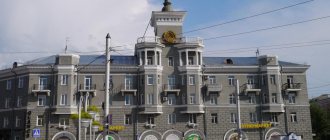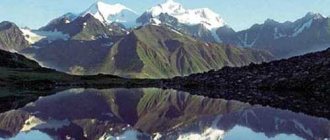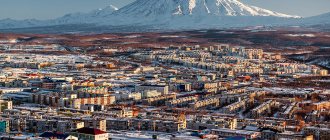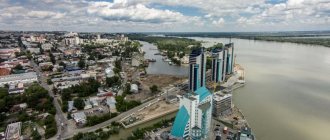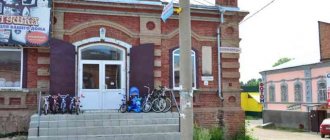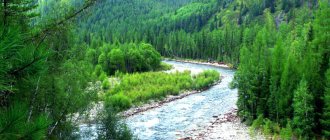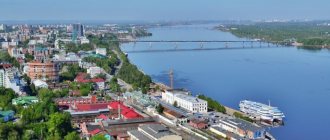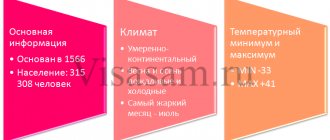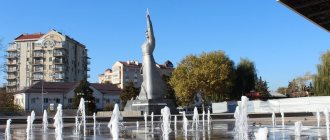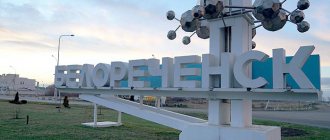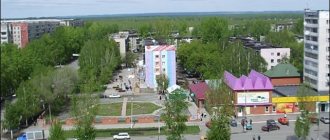- June 8, 2019
- Directions
- Lena Leto
The city of Barnaul (Altai Territory) is not a particularly popular destination for tourism, although it has its own history and a number of interesting attractions. Many people have a hard time imagining where it is and don’t know anything about its specifics. We will tell you about the capital of the Altai Territory, its history, geography, population and the most interesting sights.
Where is
Many residents of the European part of Russia, hearing the phrase “city of Barnaul,” ask the question: “Where is it?” And this is not surprising, because this city is separated from Moscow by 3 thousand kilometers. And the Altai Territory in Russia is not the most important and famous region. However, it is worth understanding that Barnaul is located in the south of Western Siberia, at the confluence of the Barnaulka River and the Ob. The city is surrounded on one side by the Ob River, and on the other by a ribbon forest.
Barnaul is the only city in Russia that is located on the banks of a large river, but only one bank of it is developed. The city has long dreamed of starting to expand towards Novoaltaisk, on the right bank, but these plans remain unrealized. The city is located in the forest-steppe zone, characterized by a predominantly flat landscape. The city area is also mostly flat with a few small hills. The nearest large city is Novosibirsk, 239 km away.
Altai Museum of Local Lore
On Polzunov Street there is the Altai State Museum of Local Lore. It is considered the first in Western Siberia. The opening took place in 1923.
The idea belonged to the manager of mining factories in the Barnaul region, Pyotr Frolov, and the naturalist scientist Friedrich Gebler. At that time the museum was called the “Mountain Museum”.
The exhibition was based on models of mining machines and various mechanisms of mining production and an extensive collection of minerals from the Urals.
Of great interest to visitors is the inspection of the first steam engine of the Russian inventor Ivan Polzunov. In 1766, this outstanding man built the first heat engine (steam engine) in Russia, which he invented, on the banks of Barnaulka.
Tourists are given the opportunity to examine models of industrial machines of the 18th-19th centuries and other various mining equipment of those times.
Climate and ecology
The capital of the Altai Territory has an unusual geographical location, which affects its climate. It is exposed to air masses from the Atlantic, the steppes of Central Asia and the Arctic Ocean. Only the Altai Mountains protect it from the eastern winds. Therefore, the climate in the Barnaul region is sharply continental. It is characterized by significant contrasts in weather. There are moderately snowy, frosty winters and warm, moderately humid summers. The region has a fairly high rate of sunshine - 2180 hours, for example, in Sochi it is 70-80 hours more. Barnaul has pronounced seasonal variations; there is a noticeable difference between spring, summer, autumn and winter.
The ecological situation in the city is quite satisfactory. Since in the capital of the Altai Territory there have been noticeably fewer industrial enterprises in recent years, the air has become cleaner. In winter, the situation is only worsened by private houses that are heated with coal, but there are fewer and fewer of them due to gasification. Transport is a major contributor to air pollution, but is not currently an environmental problem. But the situation with solid household waste is acute. All areas around the city are turning into unauthorized landfills, and this has a negative impact on the condition of the unique belt forest, which goes directly to the city. The forest is also threatened by logging, which is being carried out for the construction of residential buildings.
Administrative division
The banks of Barnaulka are considered to be the place from which the city began to grow. The Ob River in Barnaul became a natural barrier that the city did not cross. Therefore, the entire settlement was located on the left bank of the large river. The city is divided into 5 administrative districts: Central, Zheleznodorozhny, Oktyabrsky, Leninsky and Industrial. The city also includes 24 settlements: the villages of Yuzhny, Borzovaya Zaimka, etc. The local population of Barnaul also divides the city according to the traditional names of settlements or places that are included within the city. So, here you can hear such toponyms as Aviator, Solnechnaya Polyana, VRZ, Sulima, Cheryomushki.
Economy
The capital of the Altai Territory, its economic center in Soviet times was a fairly large industrial city. After the collapse of the USSR, many industrial enterprises ceased to exist, and the city began a slow decline. Today, the city has several large enterprises in the chemical, engineering and metalworking industries. There are also many successful agricultural processing enterprises in Barnaul. This is not surprising, because the Altai Territory is an agricultural region. But still, most of the population of Barnaul is engaged in trade. The city has many shopping centers and various commercial enterprises. Important for the city's economy is its convenient location at the intersection of some important transport routes. Barnaul has its own airport named after. G. Titov, a branch of the West Siberian Railway passes through the city.
Population
At the end of 2022, 632 thousand people lived in Barnaul. Over the past couple of years, the number of residents of Barnaul has been decreasing. This can be explained by migration and natural decline. The capital of the Altai Territory is a fairly compact city, its area is 322 km². The population density is 1955 people/km². By gender, the groups of city residents are 55% women, 45% men. In terms of ethnic composition, the city differs little from many other settlements in the country. 95% of Russians live here, other nations are represented by groups of less than 1%.
Famous people[edit]
- Andrey Svechnikov, ice hockey player; 2nd overall in the 2022 draft by the Carolina Hurricanes
- Evgeni Svechnikov, Detroit Red Wings NHL prospect
- Maria Butina, political activist and alleged Russian agent
- Pyotr Kozmich Frolov, scientist and inventor
- Tatyana Kotova, Olympic champion in long jump
- Julia Neigel, singer, songwriter
- Ivan Nifontov, world champion and Olympic medalist in judo
- Alexey Novikov-Priboy, writer
- Ivan Polzunov, inventor, creator of the world's first two-cylinder engine
- Konstantin Shcherbakov, pianist
- Sergey Shubenkov, track and field athlete, 2015 world champion [27]
- Nadezhda Shuvaeva-Olkhova, Olympic basketball champion
- Alexey Smertin, former captain of the Russian national football team
- Rita Streich, coloratura soprano
- Nikolai Yadrintsev, researcher and archaeologist, among the discoveries - Orkhon writing, the capital of Genghis Khan, Karakorum.
- Mikhail Yakubov, professional ice hockey player in the NHL and KNL
- Mikhail Evdokimov, comedian, former governor of Altai Krai
City `s history
In the place where Barnaul is located today (Altai Territory), the first people lived back in the Stone Age. And even before the Russians appeared in this region, the Horde fortress Abaksha stood in this place, from which the Teleuts carried out devastating raids on neighboring settlements. But the real history of the city of Barnaul begins in 1730, when the miner Akinfiy Demidov organized the first settlement to build a copper and silver processing plant. When the plant started operating, people from all over the area flocked to the city. A whole group of St. Petersburg engineers and officers arrived to work at the plant. In 1748, the office of the mountain district was moved from Kolyvan to Barnaul. In 1771 it acquired the status of a mountain town. Barnaul is being built on the model of St. Petersburg. A library, a theater house, and a local history museum appeared. The city is becoming not only a mountainous city, but also a cultural and educational center of the region. But gradually mining fell into decline, and at the end of the 19th century Barnaul became a merchant city. When the railway came to the region, the merchants abandoned the plan according to which the line would pass through Barnaul. And this had a negative impact on the development of the city, which gradually lost its regional significance.
In 1917, a terrible fire occurred in Barnaul, which destroyed 40 city blocks. Restoration began only after the 19th century, already under Soviet rule. During the Soviet era, the city developed as a large industrial center; a number of factories opened here, some of which were evacuated here during the Second World War. After the collapse of the USSR, the city experienced difficult times associated with the closure of a large part of industrial enterprises. Today, the city is regaining its status as a major center of the agro-industrial sector; large residential construction is underway here, although difficulties in the development of the city remain, this is confirmed by the large number of citizens leaving.
Intercession Cathedral
We already know where Barnaul is located. Let's talk about one more of its attractions. Since 1898, in the western part of the city, at the expense of the population, on the site of the old wooden Church of the Intercession, construction began on the red brick four-altar Church of the Intercession. The cathedral was consecrated in 1904 in honor of the Intercession of the Holy Virgin.
In 1937 the temple was closed. And its building was used for city needs, and the frescoes that decorated the temple interior and the bell tower were damaged. In 1944, at the request of the diocese of Barnaul, services were resumed in the church. Then the gradual restoration of the church began, which lasted until 1993.
During this time, frescoes based on religious paintings by artists Viktor Vasnetsov, Ivan Kramskoy and other Russian painters, a bell tower and the building of a Sunday Orthodox school for youth of the Barnaul region were restored. Now the Intercession Cathedral is a functioning temple and is open to everyone.
Culture
Like other large cities of the Altai Territory, Barnaul has a cultural life, although it cannot be called too vibrant and diverse. There are 4 state theaters and a philharmonic society in Barnaul, as well as several private small theaters. There are also several museums and art galleries in the city. The newest museum is the Mountain Pharmacy, a restored original 19th-century pharmacy. Also in Barnaul there is an unusual auto theft museum named after Yuri Detochkin and a museum of time, which contains household items from the 19th and 20th centuries. Children especially love the interesting museum of entertaining sciences “How so?” During Soviet times, Barnaul had an extensive network of cinemas. Today, this area is represented by the Kinomir chain and individual cinemas Pioneer, Matrix and Formula.
Links[edit]
Footnotes [edit]
- ^ abcde Law No. 28-ZS
- ↑
According to Article 5 of the Barnaul Charter, the official symbols of the city, archived on February 24, 2022 at the Wayback Machine, include only the flag and coat of arms. - ^ abc Charter of Barnaul, article 4
- ^ abc Encyclopedia of Russian Cities
. Moscow: Great Russian Encyclopedia. 2003. pp. 36–38. ISBN 5-7107-7399-9. - Charter of Barnaul, article 37
- Official website of Barnaul. City Administration Archived June 22, 2022, at the Wayback Machine (in Russian)
- Charter of Barnaul, article 46
- Official website of Barnaul. Geography archived June 2, 2022, at the Wayback Machine (in Russian)
- ^ abc Federal State Statistics Service (2011). “All-Russian Population Census 2010. Volume 1" [All-Russian Population Census 2010, vol. 1]. All-Russian Population Census 2010 [All-Russian Population Census 2010]
. Federal State Statistics Service. - https://www.gks.ru/free_doc/doc_2018/bul_dr/mun_obr2018.rar ; archive date: July 26, 2022; received: July 25, 2022; Archive URL: https://web.archive.org/web/20180726010024/https://www.gks.ru/free_doc/doc_2018/bul_dr/mun_obr2018.rar.
- ^ a b Charter of the Altai Territory, Article 6
- ^ abc Law No. 144-ZS
- "On the Calculation of Time". Official Internet portal of legal information
. June 3, 2011. Retrieved January 19, 2022. - Post office. Information and computing center of OASU RPO. ( Post office
).
Search for postal service objects ( postal Search for objects
) (in Russian) - ↑
Federal State Statistics Service of Russia (May 21, 2004).
“The population of Russia, the constituent entities of the Russian Federation as part of federal districts, urban settlements, settlements, settlements of 3 thousand or more people” [Population of Russia, its federal districts, federal districts, districts, urban settlements, rural settlements - administrative centers and rural settlements with a population of more than 3,000 people] (XLS). All-Russian Population Census 2002
. - “All-Union Population Census of 1989. The current population of union and autonomous republics, autonomous regions and districts, territories, negative phenomena, urban settlements and rural district centers” [All-Union Population Census of 1989: current population of union and autonomous republics, Autonomous regions and districts , territories, regions, districts, urban settlements and villages performing the functions of district administrative centers. All-Union Population Census of 1989 [All-Union Population Census of 1989]
.
Institute of Demography of the National Research University: Higher School of Economics [Institute of Demography of the National Research University: Higher School of Economics]. 1989 - via Demoscope Weekly
. - “All-Union Population Census of 1979. National composition of the population by regions of Russia” [All-Union Population Census of 1979. Ethnic composition of the population by regions of Russia] (XLS). All-Union Population Census of 1979 [All-Union Population Census of 1979]
.
1979 - via Demoscope Weekly
(website of the Institute of Demography of the State University - Higher School of Economics. - Minns, Ellis Howell (13 January 2011). Scythians and Greeks: a survey of ancient history and archeology on the northern coast of the Euxine Sea from the Danube to the Caucasus. Cambridge University Press. ISBN 9781108024877. Retrieved January 1, 2022 - via Google Books.
- "Fifth Wartkin Readings". new.hist.asu.ru.
_ Archived from the original on July 25, 2012. Retrieved January 1, 2022. - Sanborn, Josh. "Mobilization of 1917 and the question of the Russian people." Slavic Review,
vol. 59, no. 2: pp. 267–89. - ^ a b Lambert, Gavin (2004). Natalie Wood: A Life,
London: Faber and Faber, p.8. ISBN 978-0-571-22197-4 - [1]
- "Archival copy". Archived from the original on October 27, 2012. Retrieved 28 March 2015.CS1 maint: archived copy as title (link)
- "Barnaul". Encyclopedia Britannica
. Retrieved November 8, 2022. - "Weather and climate - climate - Barnaul" (in Russian). Retrieved May 14, 2015.
- "Climate norms for Barnaul". National Oceanic and Atmospheric Administration. Retrieved January 23, 2013.
- “Sergei Shubenkov won” gold at the World Athletics Championships in Beijing. Retrieved January 1, 2022.
- “USA, Spain and China: in what other countries does Barnaul have sister cities?” . tolknews.ru
(in Russian). Plot. October 31, 2022. Retrieved November 30, 2020. - “The city of Shumen - No matter what you decide.” tourism-shumen.com
(in Bulgarian). Tourism Shumen. Retrieved July 14, 2020.
Sources [edit]
- Barnaul City Duma. Decision No. 789 of June 20, 2008 “Charter of the urban district - the city of Barnaul, Altai Territory,” as amended. Decision No. 766 of March 31, 2022 “On amendments to the Charter of the urban district - the city of Barnaul, Altai Territory (as amended by Decision No. 706 of December 16, 2016).” Came into force on the date of official publication (July 15, 2008) (subject to certain provisions that entered into force within the specified periods). Published: “Evening Barnaul”, No. 103, July 15, 2008 (Barnaul City Duma. Decision No. 789 of June 20, 2008. Charter of the urban district - the city of Barnaul, Altai Territory,
as amended by decision No. 766 of March 31, 2022 “
About amendments to the Charter of the urban district - city").
Barnaul, Altai Territory (edition No. 706 of December 16, 2016) . Effective from the date of official publication (July 15, 2008) (except for paragraphs that come into force on other dates). - Altai Regional Legislative Assembly. No. 3-ZS June 5, 1995 “Charter (Basic Law) of the Altai Territory,” as amended. Law No. 118-ZS of December 1, 2015 “On amendments to the Charter (Basic Law) of the Altai Territory.” Published: “Altai Truth”, No. 100, June 14, 1995 (Legislative Assembly of the Altai Territory. No. 3-ZS dated June 5, 1995. Charter (Basic Law) of the Altai Territory
as amended by the Law of December 1, 2015 No. 118-ZS “
On amendments to the Charter (Basic Law) of the Altai Territory
).” . - Altai Regional Council of People's Deputies. Law No. 28-ZS of March 1, 2008 “On the administrative-territorial structure of the Altai Territory,” as amended. Law No. 16-ZS of April 4, 2022 “On the annexation of the Zheleznodorozhnaya Kazarma station 572 km to the Oktyabrsky village of the Oktyabrsky village council of the Kulundinsky district of the Altai Territory and amendments to certain laws of the Altai Territory.” Entered into force on March 8, 2008. Published: “Altaiskaya Pravda”, No. 67, March 8, 2008 (Council of People’s Deputies of the Altai Territory. Law of March 1, 2008 No. 28-ZS “ On the administrative-territorial structure of the Altai Territory”
as amended by Law No. 16-ZS dated April 4, 2022
On the annexation of the Zheleznodorozhnaya Kazarma station 572 km to the Oktyabrsky village of the Oktyabrsky village council of the Kulundinsky district of the Altai Territory and on amendments to various laws of the Altai Territory
. Effective from March 8, 2008). - Altai Regional Legislative Assembly. Law No. 144-ZS of December 27, 2008 “On the status and boundaries of the municipal and administrative-territorial formation of the city of Barnaul, Altai Territory,” as amended. Law No. 44-ZS of July 2, 2009 “On amendments to Appendix 1 to the Law of the Altai Territory “On the status and boundaries of the municipal and administrative-territorial entity of the city of Barnaul, Altai Territory””. Came into force 10 days after the day of official publication. Published: “Altai Truth”, No. 5–6, January 15, 2009 (Legislative Assembly of the Altai Territory. Law No. 144-ZS of December 27, 2008 “ On the status and boundaries of the municipal and administrative-territorial formation of the city of Barnaul, Altai Territory
in ed. July 2, 2009
On amendments to Appendix 1 of the Law of the Altai Territory “On the status and boundaries of the municipal and administrative-territorial formation of the city of Barnaul, Altai Territory"
. Valid from the day that is 10 days after the day of official publication.).
Barnaul - the capital of the world
Many cities have their own legends and myths, persistent stereotypes. There is one in the capital of the Altai Territory. There is a half-joking saying in the city: “Barnaul is the capital of the world.” It appeared during the period of perestroika. There are several versions of who first said it. But most of the local residents say that it was first heard in the song of the local rock band The 9. And later it was picked up by the writers the Orekhov brothers, who wrote fantastic stories and created a story called “Barnaul - the capital of the world”, the prototype of which was one of the characters musician of the group “9” Sergei Lazorin. This phrase became a kind of slogan for the avant-garde creative youth of the 90s. Now this expression has become part of local folklore and is popular among middle-aged Barnaul residents.
Attractions
When tourists plan to visit the Siberian city of Barnaul, they think about what they can see there. The first thing guests arriving by car see are large white letters in Nagorny Park a la Hollywood, as well as a long bridge across the Ob River. They also have a view of the old city, where the main attractions are concentrated. These include monuments of wooden architecture, in particular the House of the architect Lesnevsky, the house of the merchant Shadrin, the house of the architect Nosovich. The turn of the 19th and 20th centuries is represented by several beautiful stone mansions. The most interesting are the house of merchants Yakovlev and Polyakov, the Philharmonic building, the former People's House, and the city hall building. The Soviet period was the time when the complex of the city’s main street, Lenin Avenue, was formed. It is built up with buildings in the Stalinist Empire style. The most striking building of the Soviet period is the House under the Spire, which has become a real symbol of the city. Important architectural monuments are the city's cathedrals - Pokrovsky, Nikolsky, Znamensky.
Museum of Auto Theft named after. Yuri Detochkina
On Koptevskaya Street, in the building of the Favorit Motors car dealership, a kind of museum has been operating since 2003. It has become popular among tourists - the auto theft museum, named after the main character of the comedy "Beware of the Car". There is an exhibition of various master keys and devices used by car thieves in the city.
The museum was created on the initiative of the regional rescue service. She subsequently provided him with all the videos of the traffic accidents. Visitors can watch them in a specially equipped cinema hall.
Things to do
The city is not only architecture and monuments, but also parks and squares. In Barnaul, the beautiful Ob embankment has recently been decorated, along which you can take pleasant walks. The city is located on the border with a unique ribbon forest, where you can also take pleasant walks. You can also spend a few pleasant days in sanatoriums and holiday homes. The Altai region is famous for its beautiful nature and there are several excellent places to relax right within the city limits. You can also go for a walk to the arboretum, which is especially beautiful in the spring, when many varieties of lilac, apple and cherry trees bloom.
Demidovskaya Square
The walking tourist excursion begins with the main attraction of the city - Demidov Square. It is located in the central part
In 1818, the managers of the Kolyvan-Voskresensky factories, Pyotr Frolov, proposed creating a square in Barnaul where an obelisk could be erected in honor of the 100th anniversary of the start of mining in the Altai region.
Initially the square was called Konyushennaya. Then it changed its name several times.
From 1992 to the present time, the main square of Barnaul is called Demidovskaya in honor of the founder of the city, Akinfey Demidov. Now it looks about the same as it did in past centuries.
Tourists can explore the buildings of the mountain hospital, mining school and home for the disabled. All these buildings date back to different years of the 19th century and have retained their original appearance.
